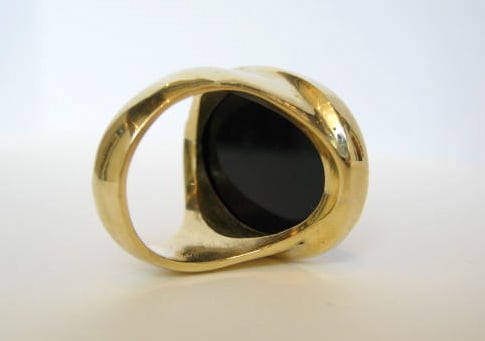Gold Ring Featuring a Roman Sardonyx Seal Depicting a Quadriga, 100 CE - 300 CE
Sardonyx and Gold
FJ.6660
Further images
This Ancient Cameo Has Been Set in a Modern 18 Karat Gold Rin Cameos are hard or precious stone carved in relief. The cameo is usually a gem (commonly agate,...
This Ancient Cameo Has Been Set in a Modern 18 Karat Gold Rin
Cameos are hard or precious stone carved in relief. The cameo is usually a gem (commonly agate, onyx, or sardonyx) having two different colored layers, with the figures carved in one layer so that they are raised on a background of the other. The cameo is the converse of the intaglio, which consists of an incised, or sunken, engraving in the same class of materials.
Cameos exist in large numbers from the early Sumerian period (c. 3100 BC) to the decline of Roman civilization, from the Renaissance to the Neoclassical period in the 18th century. While Greek cameos were purely decorative (as opposed to intaglios, which were used as seals), Roman cameos were usually carved with portraits and mythological scenes. This stunning cameo represents a chariot drawn by four horses, called a Quadriga, in the midst of a battle. This stampeding vehicle is about to trample a fallen warrior while the driver of the chariot prepares to spear this unenviable man. Perhaps this represents a scene from a historical battle or, more likely, depicts a generic highlight from a gladiatorial competition. Today, mounted in a gorgeous 18 karat gold ring, this cameo is a stunning centerpiece symbolic of the strength and fortitude of the Roman Empire.
Cameos are hard or precious stone carved in relief. The cameo is usually a gem (commonly agate, onyx, or sardonyx) having two different colored layers, with the figures carved in one layer so that they are raised on a background of the other. The cameo is the converse of the intaglio, which consists of an incised, or sunken, engraving in the same class of materials.
Cameos exist in large numbers from the early Sumerian period (c. 3100 BC) to the decline of Roman civilization, from the Renaissance to the Neoclassical period in the 18th century. While Greek cameos were purely decorative (as opposed to intaglios, which were used as seals), Roman cameos were usually carved with portraits and mythological scenes. This stunning cameo represents a chariot drawn by four horses, called a Quadriga, in the midst of a battle. This stampeding vehicle is about to trample a fallen warrior while the driver of the chariot prepares to spear this unenviable man. Perhaps this represents a scene from a historical battle or, more likely, depicts a generic highlight from a gladiatorial competition. Today, mounted in a gorgeous 18 karat gold ring, this cameo is a stunning centerpiece symbolic of the strength and fortitude of the Roman Empire.





